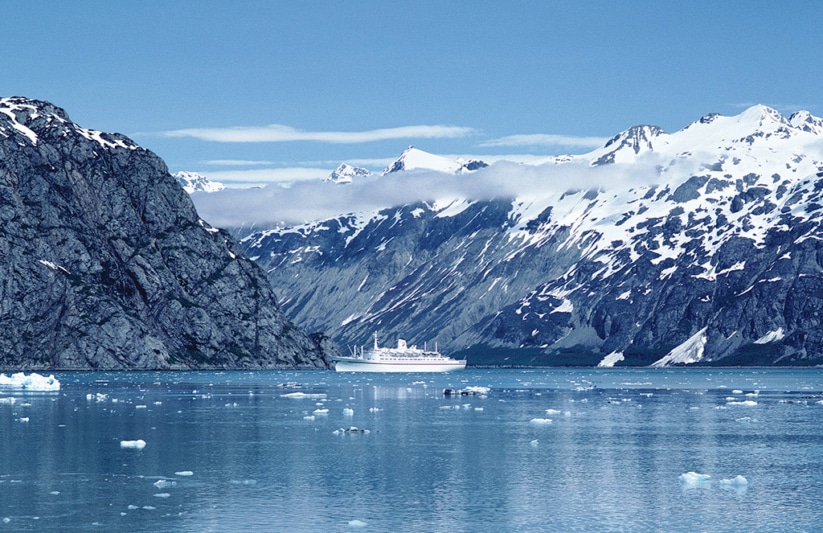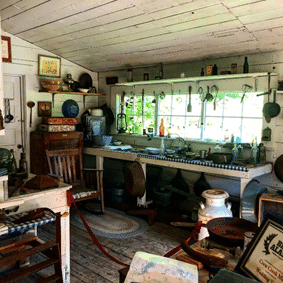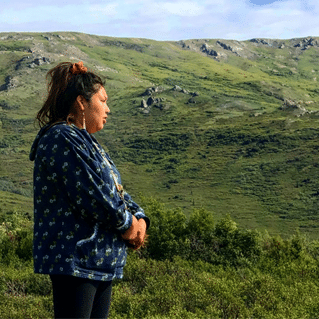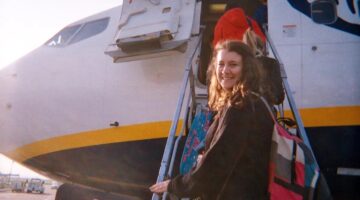Alaska: A Lesson for Everyone

This past summer. I had the great fortune of traveling to Alaska to experience the sites and stories of the itineraries ACIS has recently added to our offerings. As a self-proclaimed adventure seeker, I have ventured to many countries (32 to be exact) to expand my understanding of the world we live in. Alaska was on my list, but the north stars aligned for me earlier than anticipated,and I am so grateful that they did.
Alaska truly is everything! It’s as picturesque as any postcard you have ever seen. Alaska is a place of inspiration, a history lesson, a laboratory. Above all, Alaska is a classroom.
There is so much to say about the great state of Alaska. The lessons that I describe below are only a small introduction of what can be experienced, and there truly is a lesson for everyone.
A History Lesson:
Though I recall learning about “Seward’s Folly” during a U.S. history course and was aware that we had purchased Alaska from Russia in the late 1800s, when and why Alaska became a state was a little hazy to me. As the 49th state added to the union, it was only in 1959 that Alaska was given an official capitol and even more importantly, official representation in our government.

Facts are easy to read (perhaps even memorize) but, as you explore the state and see the settlements and natural resources that motivated the U.S. to acquire this land from Russia, the ways in which states evolve is easier to understand.
When you adventure to the small town of Palmer and learn that in 1935 the U.S. invested $11 million to send 203 families from Michigan, Minnesota and Wisconsin to help develop the farming infrastructure of the area, you get a history lesson that truly comes to life. While visiting Crow Creek Mine, students learn about the ‘gold fever’ of the late 1800s and the Alaska Gold Rush that encouraged over 100,000 people to migrate to the icy tundra for a wealthier fate. Stories like these are told in every town visited and bring to life the realizations of urban development.
Counter balancing these tales of US expansion are the amazing stories of the indigenous peoples of Alaska, which I’ll discuss in greater detail later on.
(Pictured above: An example of a home a gold miner in Alaska)
An Economics Lesson:

At 663,300 square miles (two times the size of Texas), the land of Alaska is one of the last great areas of natural resources in our country. The animal resources of dairy, crabs, fish, fur and the natural resources of gold, coal and oil are all examples of the very lucrative motives for the Alaska Purchase. Public opinion of this historical acquisition may vary, but in the 1800s Alaska was believed to be the gateway to trade with East Asia. With a population of less than 750,000 for the entire state (by contrast Texas’ population is 28.7 million), a large majority of the people that live in Alaska are connected to one of these resources.
An Art Lesson:

Perhaps more of a subjective opinion, the scenery of Alaska is inspiration for a creative’s mind. I like to dabble in iPhone photography, and I was tempted to pick up some watercolors and recreate the beauty of the landscape. Be it poetry, creative writing, painting, photography, sculpturing, etc. Alaska will invigorate the soul. For our younger travelers that love to connect to their phones, with the vast outdoors and fewer cell towers, the opportunity to soak in the panorama may be what inspires new mediums of creativity.
A Lesson on Wildlife:

Did you know that bear spray was a thing? Well, it is and it is a very real purchase for Alaskans. Though the bear pictured below is from the Alaska Wildlife Conservation Center and will eventually venture back out to his natural “wild” lifestyle, the chance of meeting a bear – or moose, or dall sheep, or mountain goat, or reindeer – is a reality. If you enjoy watching the National Geographic channel, I can say firsthand, my time in Alaska felt like I was a National Geographic cast member. Alaskans have learned to cohabit with wildlife. These animals all play integral parts to the ecosystem of their land. Yes, Alaskans carry bear spray like I carry Chapstick, but the lesson of sharing our land so freely with the other species of our world left me in awe.
A Lesson in Marine Biology:
Yes, marine life is technically wildlife, but in Alaska, it warrants its own course title. I hardly know where to start. Perhaps I should highlight Seward. As a port town on the inlet of the Kenai Peninsula, the small coastal community may be my new dream town. Imagine boarding a boat and within an hour gliding by seals, puffins, sea lions and whales – It is a dream!
While at the Alaskan Sea Life Center, I happened upon a man staring at a tank, watching a large sea creature. Fixated by every second of this mystery animal’s movements the man shared that it was a Pacific Sleeper Shark (a close relative of the Greenland shark). This shark is said to live 200-300 years and could teach us a tremendous amount of information about cold water ecology.
I later learned that I was talking to Dr. Horning and had seen a historical moment in his research. This was the first Pacific Sleeper shark successfully found for research purposes. Of course, the shark was only going to be at the center for a few days (the ethos of an Alaskan is protecting the wildlife), but in one day and 20 hours of sunlight, I learned more about sea life than ever before.

Homer, another town commonly visited on our itineraries, provides a tremendous amount of education on marine research as well. Students spend a day (and night if they choose) in Kachemak Bay helping with the collections of plant and animal life for research and understanding how this data is used by marine biologists. The lessons learned in Homer are equally educational.
Moral of the story: if you have students that are passionate about marine ecology and biology, Alaska is the place to go.
A Lesson in Earth Science:
Another area of learning that warrants a million pages of stories and experiences for students is earth science. Be it earthquakes (Alaska has had years of 10,000 earthquakes in 365 days), to volcanic activity, there is a lot that can be studied (maybe even felt) about the composition of our earth. Have your students take a look at this website to see daily updates on volcanic activity.
What about global warming? How does a journey through Alaska demonstrate the gravity of our human footprint? While hiking to Exit Glacier to see how quickly the ice caps are melting or while aboard the Kenai Fjords Glacier Cruise and watching the calving of an ice wall in person, the impacts of our warming planet are seen firsthand. Humbling, even scary, my time near these glaciers reminded me about the importance of staying attuned to the ways I can help change the future of our world.

Another humbling moment was driving past a wildfire of Alaska. In 2019, 659 wildfires burned 2.5 million acres of land. While wildfires are a natural phenomena, the rate of extreme speed at which glaciers are melting and the record heat that Alaska has been reporting these past few summers are all causes for concern. I had rarely heard about the wildfires in Alaska, but it is a very important reality that we need to be more aware of.
Depending on the time of year, students will also learn about the Northern Lights and the endless summer sun. The earth science lessons learned in Alaska are endless and illuminating and will expand the walls of any science classroom.
A Lesson in Culinary Appreciation:

I am a foodie. Understanding the culinary culture of any destination is always a priority during my travels. Food is a universal necessity. The animals and land resources that are near you dictate what you consume and how you eat it. It is an expression of cultural identity. Salmon, caribous, reindeer, crab, halibut, and radishes were all of some of my favorite flavors of Alaska. If you want to introduce young, aspiring foodies to fall undoubtedly in love with cold climate resources, Alaska is the culinary classroom to do it.
(Pictured: A farm-to-table breakfast featuring reindeer sausage-mmmm, mmm, good!)
A Lesson on Global Perspective:
Pictured below is a young girl from the Athasbascan tribe of the interior of Alaska. Alaska’s native history was my favorite lesson of them all. Alaska’s natives are divided into five larger communities: the Aleuts, Inupiat (Northern natives), Yuitå (Southern Eskimos), the Athasbascan (inland natives), Tlingit, and Haida (both native to the Southeast Coast).

On our visit to Denali National Park, a young member from the Athasbcan community hosted a presentation about the lifestyles of the Athasbcan culture. Despite strong pressures from governors and presidents, their community promises to never abandon the traditions of their ancestors. Athabascans believe in the respect of animals and the land. They emphasize the importance of sharing and the nobility of humility. They are a beautiful people that should never be forgotten.
I left this young Athasbacan’s presentation teary eyed. Though we describe the United States as a melting pot of cultures and people that have immigrated to these lands in our 400 years of history [read: Plymouth Rock], there were people here before us that navigated our lands for thousands of years. A visit to Alaska reminded me of our country’s true history. Native American communities date back to 10,000 BC when Asian immigrants first crossed the Bering Bridge. The history of these Native American people whose voices and perspectives are rarely included in written histories, reminded me that I missed learning quite a bit of American history. With over twenty vernaculars spoken throughout the state, and a rich history of trade with Russia and Asia, a visit to Alaska tells a story about trade and the impacts of globalization that predates the Mayflower.
A Lesson in Independence:

As influencers of future generations, an important mission of educational travel is to teach independence. There are different survival skills learned (remember the bear spray?). For some the lesson is how to survive without cell reception for a few hours or how to survive without Amazon Prime (not everything can get to Alaska in 24 hours). For others the lessons may teach outdoor survival, like how to fish for your own food and plan for overnights in a yurt on a private island. No matter what, a visit to Alaska will remind students of the power of travel and the ability to do so without your parents by your side.
A Lesson in Fun:
Life is an adventure. While my time spent in Alaska was eye-opening and humbling, I can’t deny that Alaska is still a playground! Alaskans are always up to something adventurous and seemingly crazy. Hiking, creek mining for gold, exploring the remote wilderness, Alaska is just so much fun! Alaska does not need to be saved for your retirement, we need to rock Alaska and make it the place that every young traveler begs to visit.
Not explained in enough depth were my visits to Denali, riding a bush plane over glaciers, cuddling with Alaskan puppies while learning about the Iditarod with famous dog-sled leader, Martin Busser and so, so much more.
Everyone has to go to Alaska. I am so glad that ACIS found the perfect Alaska adventures for our students. I cannot wait to work with more educators to get our travelers there! Let’s #RockAlaska and empower our future generations to learn the lessons that really matter!










Global Teacher Conference? I’d love to learn about it first hand!
That is definitely some food for thought! We’ll float the idea at our next planning meeting for GTCs.